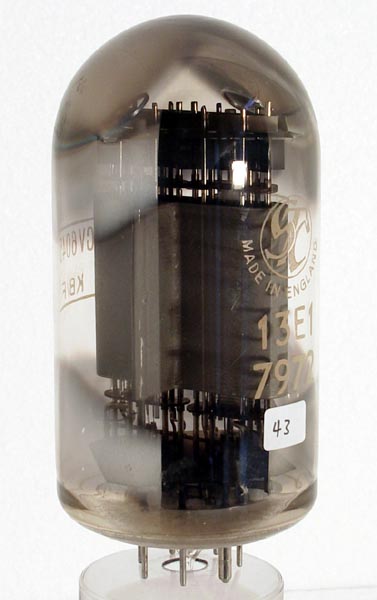|

The S11E12 belongs to a small class of professional valves which includes the 12E1 and the 13E1. The intended use of these valves is as series-mode voltage stabilisers. Series stabiliser duty is particularly tough on valves, leading to rugged design and special quality specifications. Professional equipment designers have therefore found other uses (eg. pulse applications) for valves originally designed as series stabilisers. Interestingly Mullard specify their television line output valve PL81 as also suitable for series pass duty.
For most applications the average current drawn is much less than the peak value, but for power supply use the average current is much higher and this is very demanding on the cathode. Thus special valves like these were produced to give a long service life in such arduous conditions. Generally over-sized cathodes were employed with a corresponding increase in heater power requirements.
Suppose, for example, a carefully-calibrated radar set can maintain its correct calibration only if powered from a 300 V rectified HT supply which does not vary by more than + one Volt even if the radar's diesel generator coughs and splutters a bit. The designer might provide an HT rectifier rated to give (say) 400 V DC, plus or minus ripple and other variations due to generator or load variations. This leaves roughly 100 V of spare HT, plus or minus unwanted variations, on top of the required 300 V. This surplus voltage is removed by passing the HT current through a series-mode stabiliser valve. The voltage thus removed is equal to the anode-to-cathode voltage across the series valve.
The grid of the series valve is controlled by a circuit which senses whether the HT level as fed to the radar is (slightly) above or below a stabilised 300 V reference level. If below, the control circuit raises the grid of the series valve so that it lets through more current, reducing the voltage drop across it. If above, the grid voltage of the series valve is correspondingly reduced. The scheme is essentially a high power DC negative feedback system designed to maintain the HT level at the cathode of the series valve at exactly the level of the reference voltage. In some series stabiliser units the reference is made adjustable so that the user can set the stabilised output voltage to exactly the level he desires. Of course, nowadays all this would be done using thyristors or switch-mode power supplies but during the 1950s and 1960s valved series stabilisers were very important in professional applications.
An advantage of the scheme is that by a simple modification of the control amplifier the stabilised output voltage can be set to any desired value provided sufficient voltage drop is available across the series valve. Precision variable-voltage HT power supplies can therefore be provided for laboratory use. Moreover, by adding a current-sensing resistor to the control amplifier the maximum HT current output (eg. if accidentally short-circuited) can also be set to any desired safe value. However, in this case the anode dissipation in the series valve will be much greater, eg. 100 W (250 mA @ 400 V drop). This is why valves such as the 13E1 require 100 W anode rating, and need to be tough.
The ratings of a series stabiliser valve relate to the maximum HT current it is permitted to supply and the wattage dissipated due to the voltage drop. The anode dissipation rating of the S11E12 is around 25 W so, assuming an average voltage drop of 100 V, one valve could be used to supply up to 250 mA of stabilised HT current. The anode rating of the physically larger type 12E1 is 35 W so it could supply the same current at up to 140 V drop. It would therefore be preferred for applications where large mains voltage surges or 'brown-outs' were expected.
Of course, tough, high-slope valves such as the 12E1 and 13E1 have over the years found other uses. The 13E1 has been used professionally both as a high-power pulse generator (it will deliver 7 kW pulses at modest duty factor) and as a (long wave) broadcasting transmitter. Both types remained in the lists until the 1980s and the last known professional use of the 13E1 was in 1997.
|